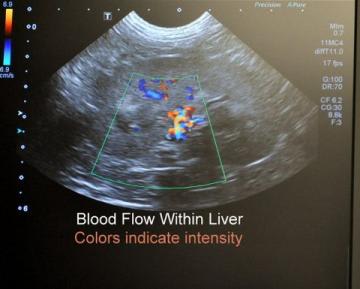
Ultrasounds serve as an invaluable diagnostic tool for veterinarians. By creating amazingly detailed images it improves our veterinarians' ability to make quick and accurate diagnoses. This ability can mean the difference between life and death for your pet.
Since 1998, Animal Hospital of North Asheville has been a leader in Western, NC in ultrasonography. Over the years, we have upgraded our ultrasound machine five times to be able to offer state of the art ultrasound technology. Developing technology continues to improve the ability of ultrasound machines to provide the diagnostic level of detail we want for your pet. The level of detail our machine provides can enable us to make an earlier diagnosis of problems including bladder stones, kidney disease, intestinal disease, heart disease, adrenal disease, liver disease, and abdominal masses. Early detection gives us a better chance of being able to treat or manage problems, and comfortably prolong or save the life of your pet.
Ultrasound machines have smooth probes that are gently run over the skin to send harmless extremely high-frequency sound waves into the body. Those waves, which cannot be heard or felt, bounce back to the probe and are then processed by the computer to create a live video on the screen. All that is required is for the area that we are examining to be shaved and ultrasound gel applied. Pets rest in a soft, specially shaped support called "positioners". There should be little to no discomfort involved for the pet. We can offer medication to help relax your pet if they are worried or stressed at the hospital. Almost all pets are content while the procedure is performed. Some are so relaxed that they even fall asleep during the procedure!
You have probably seen an ultrasound picture of a human baby in the womb before birth, but did you know that ultrasound is an extremely valuable diagnostic tool for animal diseases? Some of the most common areas examined by ultrasound are organs in the abdomen or the chest.

In the chest, we may find tumors in the heart, lungs, and lymph nodes that an x-ray cannot identify but an ultrasound can. Dogs and cats can develop various life-threatening heart conditions. One is cardiomyopathy; our ultrasound can differentiate between the two types so the correct medication can be prescribed. During a cardiac ultrasound, we can look at each beat of the heart, measure the volume of blood flow that the heart is pumping along with the structure and mechanics of the heart. Ultrasounds also allow us to follow the progression of the disease along with your pet's response to medication. Heart valve disease, a common source of heart murmurs in dogs, can be evaluated and treatment can be determined based on the information from an ultrasound. Birth defects of the heart can often be diagnosed through ultrasound, and some of them can be treated with surgery. Our ability to diagnose heart defects often allows the patient’s family to seek surgery that affords the pet a long and comfortable life.
Abdominal ultrasound can identify benign and malignant growths on your pet’s liver, kidneys, spleen (very common in large breed dogs), or anywhere in the abdomen. The greater the detail provided by abdominal ultrasound, the earlier abnormalities like cancer can be diagnosed. The earlier the diagnosis is made, the better the prognosis. Pancreatitis can often also be identified with ultrasound. The high level of detail in our equipment makes it easier to identify tumors and abnormalities in the adrenal glands, which are very small and can otherwise be difficult to visualize. We use our ultrasound to guide a biopsy needle into a specific structure for a minimally invasive biopsy. Ultrasound of the kidneys and bladder may show stones, which are common in people in this region and also affect many dogs and cats. Pets can have intestinal disorders, and the high definition ultrasound can help to diagnose them by looking at the thicknesses of the layers of the intestinal wall. The list goes on, and we are constantly finding new ways to use ultrasound to improve our diagnostic abilities.
For our veterinarians, this machine gives us what we want: accurate, detailed, imaging that is affordable for you; imaging that is so non-invasive the pet does not even realize it is occurring; imaging that can save you money with a quick diagnosis and possibly save the life of your pet.
